


Teamfight Tactics Set 4.5 YouTube Videos Playlist
Set Four proved to be a huge success for Teamfight Tactics, bringing many players back to the game (including myself) and introducing vast numbers of new players to the autochess genre. Thanks in large part to the full implementation of TFT's mobile version, the game's playerbase exploded in Set Four to reach new heights, particularly in North America which tripled its TFT server population from 2020 to 2021. The introduction of the Chosen mechanic in Set Four proved to be overwhelmingly popular with players and Riot's design team was thrilled with the reception that the set received. Set Four went through major gameplay changes at the beginning of 2021 with the introduction of Set 4.5, the mid-set revision that largely created an entirely new gameplay structure. For example, Set 4.5 removed 22 champions and 6 traits while introducing a corresponding number of replacements. It might as well have been an entirely new set and I've found it easier to consider Set Four and Set 4.5 as standalone entities in their own right.
Several more months have passed since the release of Set 4.5 and we're rapidly drawing close to the conclusion of the set. The life of Set Four was artificially extended by the end-of-year holidays when Riot staff had time off which meant that Set 4.5 ended up being notably shorter at roughly three months duration. (I've been critical of the constant turnover and neverending patches applied to Teamfight Tactics and the fact that Set 4.5 will last for just over 90 days is very much part of this same pattern.) This article is an attempt to evaluate Set 4.5 now that its limited days are already coming to a close. I don't think that it's a stretch to say that Set 4.5 was a step backwards in several ways from Set Four. While Set 4.5 was still quite good overall, it failed to preserve the best aspects of Set Four and grew stale much more quickly. Some of this was unavoidable as the Chosen mechanic persisted for both sets and any gameplay mechanic will be less interesting on the hundredth repetition as compared with the first time experiencing it. However, there were also specific choices made by the TFT design team in terms of the traits and the champions that made Set 4.5 less of a rewarding experience to play. This is my attempt to identify some of the reasons why Set 4.5 could feel more like a Festival of Bad Beats.

I think that the best way to approach this task is to look at the traits and champions which were swapped in for Set 4.5 as compared to the ones that they replaced for Set Four. These things are important due to the biggest gameplay mechanic underlying the whole set: the implementation of Chosen units. As a reminder, Chosen units started out as a 2 star version of the champion with bonus stats and counting as two copies of one of their traits. Chosen units were fantastic as a design idea, ensuring that each game would play out differently due to the randomness of which Chosens would appear and encouraging players to adapt to what they found rather than forcing the same team composition in game after game. Someone could still force Zed in every match if they wanted but they'd likely do better by building their team around the Chosens that they saw in the shop. However, as great as the Chosen mechanic might be, it had to be tethered to a wider gameplay design that encouraged flexibility in TFT. Sets Four and 4.5 needed to be designed around the ability for players to hit a key Chosen and then be able to start pivoting into a different team setup. If this was too difficult to accomplish, if the traits in a set encouraged deep specialization and the champions required highly unique itemization, then the ability to pivot would disappear and the Chosen mechanic would largely go to waste.
So what did the TFT design team need to keep in mind when creating the various traits for Set Four? Two major principles: prioritizing flexibility between traits and avoiding too many vertical bonuses from a single trait. As an example of flexibility between traits, I'll use the example of something like the Vanguard trait or the Duelist trait. In both cases, the player can toss in a pair of these units for a modest trait bonus or dive deeper into the traits for larger bonuses. Both traits are playable at 2/4/6/8 unit levels and can be "splashed" into a variety of different team setups depending on what units happen to be appearing. At the exact opposite end of the spectrum would be the Cybernetic trait from Set Three, which had exactly six units and all six of them had to be played together to land the big trait bonus. There was no room for decision-making of any kind here and players could wind up losing through no fault of their own if Ekko refused to show up - not an example of good design. With regards to vertical bonuses, it was also important to avoid making these too powerful for the Chosen mechanic to function properly. For example, if Warlord 9 is an instant-win button, then there's no incentive ever to sell the Warlord Chosen Garen that shows up at the beginning of the game and look to roll for a new one. Heavy scaling vertical trait bonuses also encourages playing more 1 cost and 2 cost units as "trait bots" and makes it much harder to pivot between team compositions. In order to make the Chosen mechanic work properly, Set Four needed to avoid this as a design issue.
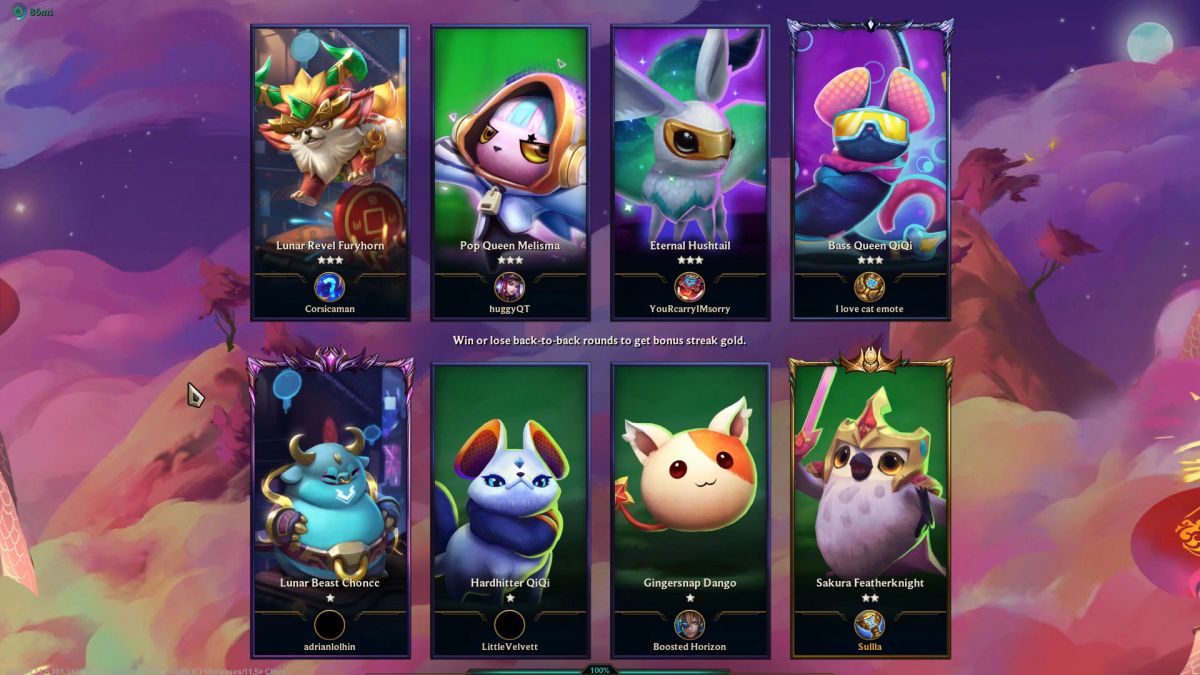
Spoiler alert: Set 4.5 failed in both of these aspects of trait design as compared with Set Four. The designers repeatedly violated both of these dictums by creating new traits that lacked the flexibility of the prior traits while simultaneously buffing the vertical bonuses granted by pre-existing traits. The best example of the latter issue came from the Brawlers trait, which inexplicably was buffed to provide attack damage along with health to its units. At the release of Set 4.5 the Brawlers 8 trait was granting all of these units something crazy like 120 AD before getting hit with nerfs. And it wasn't just the Brawlers trait either; Vanguard units received extra magic resistance to go along with their traditional armor, Assassins gained more crit chance and crit damage, Duelists received more attack speed, and so on. This is the exact opposite of what should have been happening with these traits! As the trait bonuses get stronger, it becomes harder and harder to pivot between team compositions. Players become locked into vertical silos where they're picking units solely for their traits and not for their actual abilities. There's less and less incentive to sell an early game Chosen and roll for a new one since the double trait bonus granted by the unit outweighs anything else that it might be supplying. To no surprise, the first few patches of Set 4.5 were dominated by re-roll compositions in which players grabbed an early game Chosen and never swapped for the whole game. This was a natural consequence of overbuffing the traits with too many vertical benefits.
But there was also a lack of flexibility in the new traits which can best be seen by comparing them to their replaced counterparts. While none of the new traits were a straight 1:1 replacement, most of them overlapped to one degree or another. For example, the Executioner trait ended up being similar to the previous Hunter trait, with both of them even shared by Kindred. Unfortunately the Executioner trait wound up being considerably less flexible than the Hunter trait thanks to having one fewer unit (3 as compared to 4) and one fewer trait rank available. Hunter could be played at 2/3/4/5 unit levels and also opened up at an earlier date with its presence on 2 cost Aphelios. By contrast, Executioner was less splashable at 2/3/4 unit levels and the rank 4 couldn't even be reached without hitting an Executioner Chosen. Players basically could run Executioner 2 with a pair of Kindred/Xayah/Kayle or Executioner 3 with all of them - not much of a choice there. Hunter was also more interesting by virtue of having the trait on Warwick, a melee tank in contrast to the other ranged auto attackers that shared the trait. This caused a lot of balance problems with Warwick as a unit but did create some unusual and interesting gameplay.
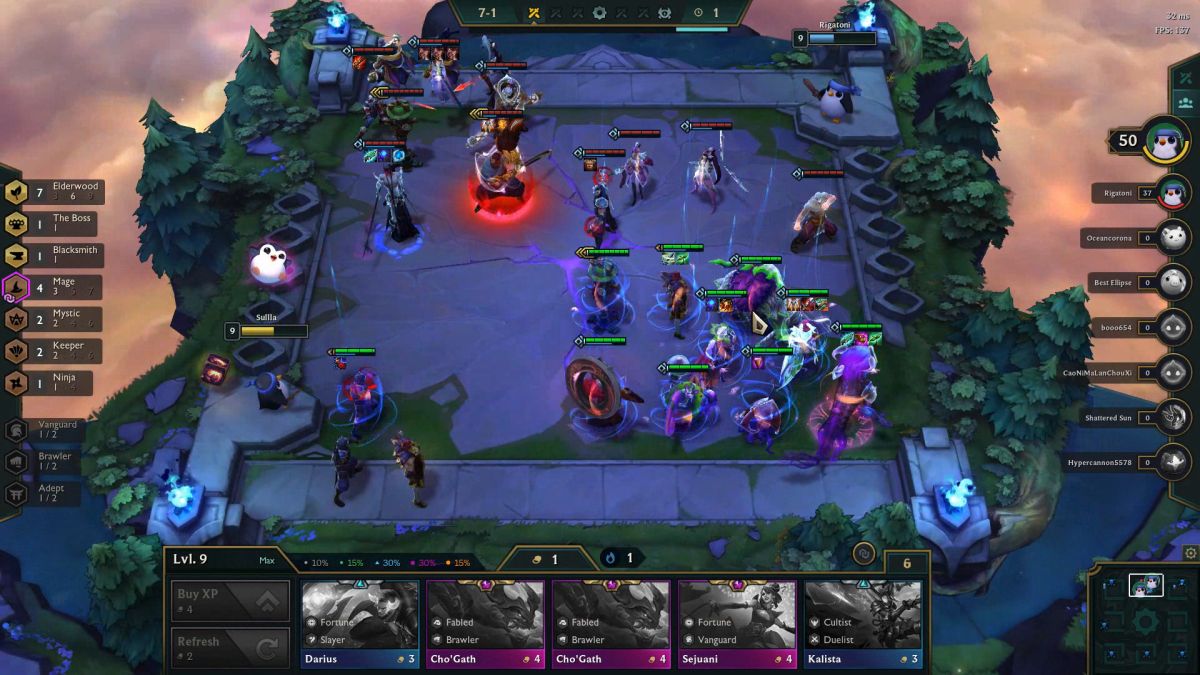
None of the other trait replacements are quite as straightforward. Fabled is probably the closest replacement for Moonlight, at least in the sense that both of them create their own separate minigame walled off from the wider gameplay. While I think that Fabled works out fine as a trait, Moonlight had the more unique design with its full embrace of re-rolling. The ability to 4 star a unit was really clever, granting early game units considerable late game power but ONLY if two different units reached the 3 star level. Barring insane luck the player would have to re-roll a lot to reach that point and therefore would be operating with fewer but more powerful units in a really cool dynamic. Fabled had both less flexibility (all three Fabled units needed to be included barring a Fabled Chosen) and lacked these unique mechanics. By contrast, I do think that the switch of Dazzler for Syphoner was a net positive overall, with Syphoner being eminently splashable into team compositions at 2 units or could reward deeper investment with 4 units. Syphoner's lifestealing could be folded into the early game with Nasus and Vlad or added in the late game with Morgana and Swain. It's the best designed of the new traits and Dazzler wasn't a terribly huge loss.
More problematic was the addition of the Slayer trait which didn't directly replace anything. (I suppose that it technically was replacing Shade thanks to the inclusion of both traits on Zed but the two shared little in common.) The Slayer trait granted extra lifesteal as the unit's health decreased and bonus damage as the target's health decreased. It had two ranks at 3/6 units but was virtually never played at the 6 unit level and therefore was pretty much always run at 3 Slayers. This was a problematic trait due to the difficulty of balancing it properly. Units that gain more lifesteal and damage as everything on the battlefield drops in health will always find themselves in difficult straights. Make the bonus too weak and they fold immediately and become useless; make the bonus too strong and they become unkillable monsters. With the Slayers trait shared by Olaf and Tryndamere and Samira, it effectively became the top late game trait in a way that wasn't very interesting. I wish that this trait had been designed more like Hunters or Sharpshooters, with a synergy pattern of 2/3/4/5 units or 2/4/6 units rather than the 3/6 setup that we ended up getting. Slayers wasn't strong enough to be worth running in the early game outside of Zed comps and in the late game it always seemed to be Pyke along with two units from the Olaf/Tryndamere/Samira trio. This wasn't one of the better additions to the gameplay.
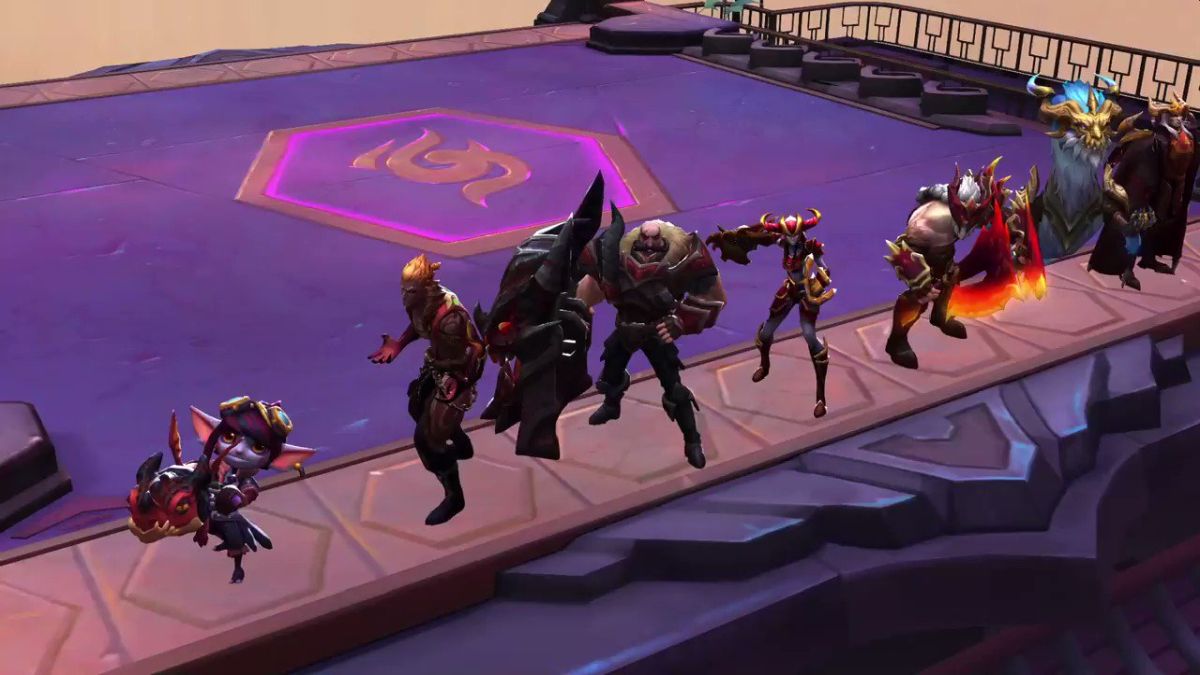
Finally we have the biggest mistake in terms of trait design in Set 4.5: the replacement of Dusk with Dragonsoul. The Dragonsoul trait literally took over the Rod + Spatula item combo to make this another pair of related traits. Dusk was my favorite trait in Set Four and I always felt that it embodied the ethos of the whole set perfectly. The trait could be played at 2/4/6 ranks and offered units that were highly flexible from the beginning of the game to its endpoint. Dusk 2 granted all champions 20% additional spell power and could be splashed into virtually any team composition by making use of Thresh (Vanguard) or Riven (Keeper) or Casseiopeia (Mystic). Set Four made it easy to toss in a pair of these units to complement other featured carries, or alternately players could invest heavily into the Dusk trait and run Dusk 4 or even Dusk 6 with a Chosen Dusk unit or a Dusk spatula (which would grant additional spell power to all units and even more to Dusk units). Dusk was versatile and always useful without being overpowered, a perfect fit for the gameplay created by the addition of the Chosen mechanic. I was shocked when I heard that it was going to be taken out for Set 4.5 since it seemed to be working exactly the way that the designers would have wanted.
In place of Dusk, Set 4.5 added the Dragonsoul trait which simply lacked the same flexibility. The trait design itself was pretty wonky: the first Dragonsoul unit to take damage in battle received the Dragon's Blessing, granting additional attack speed and spell power along with a big blast dealing 40% of the target's maximum HP on every fifth auto attack. This was quite a bit more complicated than "all champions receive 20% more spell power" and it could be difficult to get the Dragon's Blessing on the intended champion. Since only a single champion would receive the Dragon's Blessing until the later stages of the gameplay, teams featuring the Dragonsoul trait were inherently more susceptible to bad fight RNG than the flat bonus provided by the Dusk trait. Making matters worse, the Dragonsoul trait ranks were set at 3/6/9 units which made it significantly harder to splash this trait with minimal investment. Requiring 3 units to activate the trait was much trickier than needing 2 Dusk units, and even then it required getting the Dragon's Blessing to go where the player wanted it. What a pain in the rear! These issues were mitigated at higher levels of the Dragonsoul trait where more units could have the Dragon's Blessing simultaneously... but of course that required diving deeper into the trait and losing even more flexibility. Needing 6 whole units (or 5 and a Dragonsoul Chosen) was a huge commitment that few team compositions were willing to make. The ability to toss in a pair of Dusk units to complement your other Sharpshooter (Vayne) or pair an early Riven with Jarvan in a Warlord team comp (Keeper) simply disappeared and nothing replaced it in Set 4.5. The absence of Dusk left a gaping hole in the Set 4.5 gameplay and resulted in a set which was considerably less vibrant than its predecessor.

Nevertheless, Teamfight Tactics is a game that's ultimately played through units and not simply through traits. Set 4.5 removed 22 units from the previous set and added 20 units in their place to round out the new group. Unfortunately the new units mostly suffered from the same problems as the new traits: they required highly specific itemization which limited flexibility and forced players into rigid team compositions. I'm going to compare the two sets once again by looking specifically at some of the "carry" units that players built their team compositions around. I found that the early game unit balance didn't change that much between the two sets, with Tristana playing similarly to Vayne and Brand acting similarly to Nami. It was the more expensive units at 3 cost, 4 cost, and 5 cost levels that shifted the gameplay in more dramatic fashion and many of these units were pigeonholed into highly specific itemization routes. Once again, the absence of the Dusk units in particular was a severe blow.
Let's start with the new carry units that did function well in Set 4.5. I think the best of these was probably Xayah who benefitted from having three traits that could be played in several different team setups. Early in Set 4.5 players emphaized the Elderwood trait on Xayah, taking advantage of the fact that the trait was overbuffed and pairing her with Rakan and the various Elderwood Brawlers and Mages for a well balanced team. After Elderwood ate a bunch of nerfs, Xayah re-emerged as the featured unit in Keeper 4 and Keeper 6 teams to leverage its huge shielding for safety. Alternately, Xayah could be played as a secondary carry in an Executioners setup along with Kindred and Kayle. She made good use of Hand of Justice and Guardian Angel in particular but most AD and attack speed items were pretty solid choices on Xayah. This unit was the closest thing to a replacement for Ashe and her arrow-toting predecessor had similar itemization while being playable in Hunter comps or Elderwood comps. I think that this was the most direct 1 for 1 unit replacement in Set 4.5 and Xayah worked pretty well in general, playable in several different setups with reasonably flexibile itemization.
I also think that Tryndamere was a successful replacement for Xin Zhao in Warlord team compositions. Xin's ability to stack armor and magic resistance never quite worked out as intended, leaving him too weak to accomplish anything most of the time and an unkillable monster in the minority of cases where he was able to get off repeated ultimates. Trydamere was most often played as a secondary carry in Warlord or Duelist team comps, or splashed into teams for the Slayer trait in the lategame. But he could be a legitimate carry in his own right for Warlord games, especially after about halfway through the set when the developers were able to fix some of his initial bugs. Like Xayah, Tryndamere's itemization was reasonably flexible and could make use of AD or attack speed or crit items. I found myself tossing a lot of items from lategame carousels onto him after my primary carries had been fully itemized. This was one of the few units in Set 4.5 that performed better than the corresponding unit in Set Four.
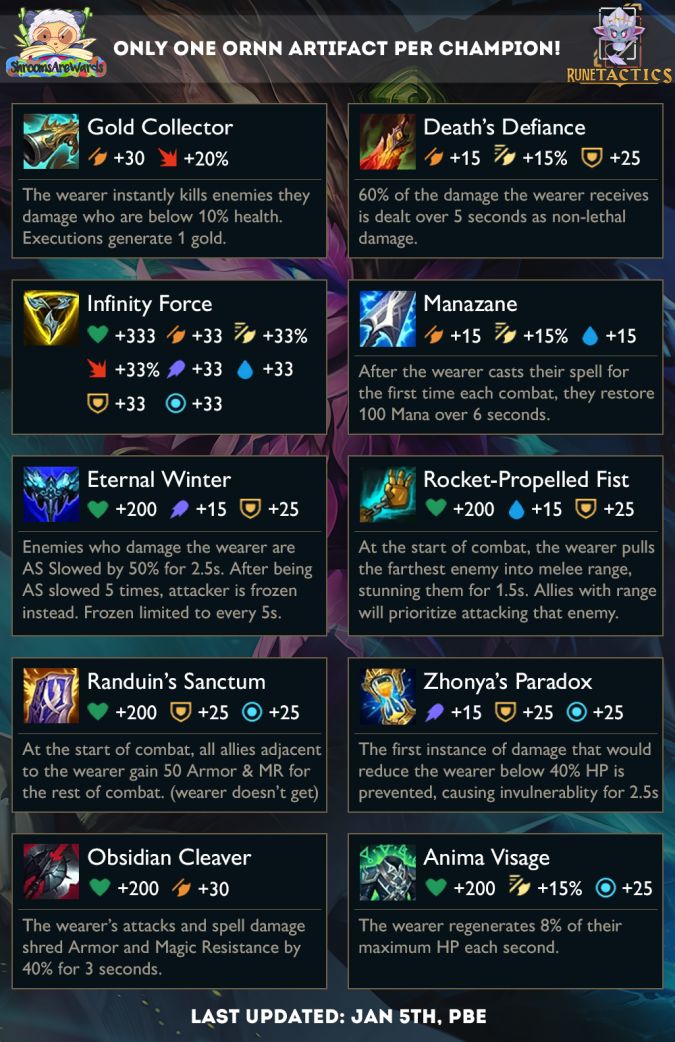
At the legendary tier, I thought that Swain was a great addition to the Set 4.5 gameplay thanks to having two traits (Dragonsoul and Syphoner) that built into a bunch of different teams. Syphoner in particular was versatile enough to be played almost anywhere and hitting a bunch of early Swains would encourage players to grab Morgana and add it to their setup. Swain was also noteworthy for being one of the very few units in Set 4.5 that could carry games with defensive itemzation (Fabled Nautilis and 3 star Annie being about the only other options). I wish that there had been a similar unit available earlier than the 5 cost legendary tier which typically didn't become available until after many games were decided. Swain was certainly more playable in a variety of team comps as compared to Kayn, with the latter unit usually only popping up in Shade or Dusk comps. Swain was also roughly about as flexible as Lillia who rarely made use of her Mage trait but could be used for fantastic crowd control in a lot of different teams thanks to carrying Dusk on her other trait. If there had been more units like Swain, I think that I would have enjoyed the design of Set 4.5 a good bit more.
Then there were a bunch of units that didn't necessarily improve over their prececessors but weren't any worse that what we had before. For example, Neeko being the featured unit for Fabled teams wasn't too different from Aphelios being the featured unit for Moonlight teams. Both units needed to hit 3 stars (or 4 stars for Moonlight) to have a realistic chance of winning the lobby and these teams usually involved a lot of re-rolling at lower levels. Sivir and Jinx played reasonably similarly as 3 cost units even if their exact functions (attack speed buff versus crowd control) and itemization wasn't fully the same. Aurelion Sol was a problematic unit in Set 4.5 because his ultimate could wipe the whole board of enemy units... but was that really different than Ahri in Set Four would could do the same thing with her spirit bomb? Both units were extremely annoying to play against without being uniquely problematic to either set.
We also had the strange case of Ornn who's worth a quick discussion. The trait design on Ornn was pretty much exactly what you'd want to see, with both Elderwood and Vanguard making him playable in a lot of different teams. He was a versatile unit that could frontline for a whole bunch of different backline carries. But Ornn wasn't a legendary unit for his tankiness, he was a 5 cost unit due to his unique ability to forge new items over time. The Ornn items (or "Ornnaments" as they were often called) carried all sorts of bonus stats that could power up an existing team to new heights. Forging three or four Ornn items over the course of a game would drastically increase the power level of the team. In exchange, Ornn himself was a fairly weak unit that didn't do very much in the course of each fight. This was a fascinating idea in concept, an underpowered unit who makes the team stronger by forging items over time. The problem was that it ultimately didn't work that well in practice, with Ornn effectively being a "win more" unit which would snowball ahead teams which were already winning while doing almost nothing for teams which had fallen behind. He was the Mejai's Soulstealer of TFT if that makes sense. Ornn caused particular issues when someone randomed into him at 1% odds at Level 7 and started forging items at the end of Stage 3 or the beginning of Stage 4. Most legendary units need to hit 2 stars to start dominating in TFT, but since Ornn's strength lay in his forging and not his actual combat abilities, an early 1 star Ornn carried way too much power. The dumb luck of getting an Infinity Force item by Stage 4 carousel simply because Ornn popped up in your shop wasn't fun or interesting. Ultimately I don't think this unit worked as intended and even though it was a creative idea I wouldn't want to see another unit like this one appear in a future set.
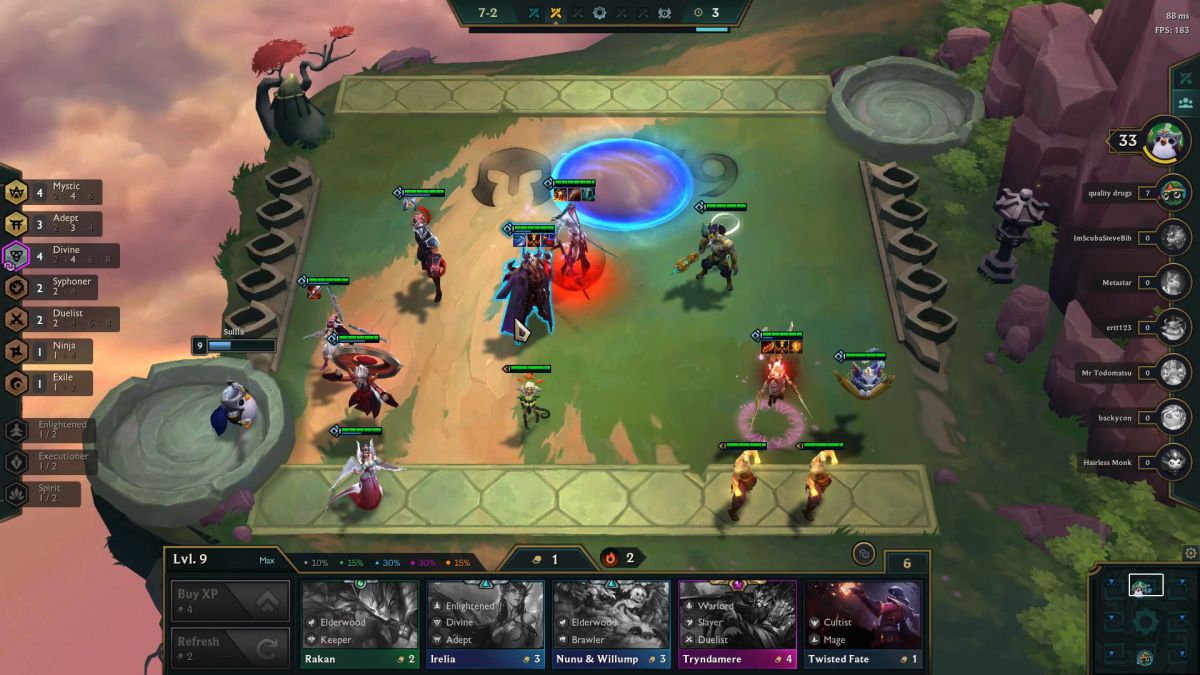
But the real troublemakers were the units that came to define the set, a series of carry units which suffered from highly specific itemization and forced entire team comps to be built around them. The poster child here was Olaf who seemed to be permanently stuck in a binary state as either uselessly weak or overpoweredly strong. Olaf's Slayer trait and his role as a melee carry fed directly into this problem; an Olaf with no items or the wrong items simply did nothing but a properly itemized Olaf could easily become unstoppable. Unfortunately Olaf also had arguably the most specialized itemization in the whole set, needing either Rapid Fire Cannon or Runnan's Hurricane to avoid getting stuck on tank units and dying without accomplishing anything. For most of the set, if the player didn't have access to bows, they couldn't play Olaf. This was not a flexible team comp and it wasn't something that could be pivoted into. Either the player had the items needed to play Olaf or they didn't, end of story.
Making matters worse, one of the other top carries in Set 4.5 was Kayle and she also had a heavy reliance on bows to form the core of her itemization. (The reliance on bows for Olaf/Kayle was so bad that for long stretches of Set 4.5 there would be half the lobby trying to claim the initial bow on the starting carousel in every game.) Kayle's top items also included Rapid Fire Cannon and Guinsoo's Rageblade along with a defensive item, preferrably a Quicksilver Sash or alternately a Guardian Angel. In other words, Kayle's preferred items were almost identical to Olaf's preferred items, and this was not healthy at all given that Olaf and Kayle comps dominated the metagame for most for Set 4.5. Kayle was also an unfortunate design choice because her two traits (Divine and Executioner) were poorly suited for splashing into other team comps. If Kayle was present in your team, then she was the featured unit something like 95% of the time. Executioner was a niche trait and Kayle was a poor choice to pick up Divine trait given other cheaper units who could provide the same function.
The net result was a pair of champions who dominated the Set 4.5 metagame while having highly specialized and extremely similar itemization. Both champions would melt the enemy team with the right items and do virtually nothing with the wrong items, exactly the sort of design trap that the Chosen mechanic should try to avoid. It was difficult to pivot into an Olaf or Kayle team since they required predetermined items and therefore players tended to force these comps from the beginning of the game. This wasn't healthy for the state of the gameplay and it was a major reason why Set 4.5 ended up feeling so much less dynamic than Set Four. The fact that Slayer comps could continue scaling into Samira only exacerbated the problem since Samira *ALSO* used many of the same items, albeit with a preference for raw AD and critical strikes over attack speed. Even with all of the nerfs that she received over time, 2 star Samira was a clear win condition and a disproportionate number of games at the TFT North American regionals were won by either Kayle teams or Olaf/Samira Slayer teams. There wasn't enough diversity of itemization on these champions and it was too difficult for players to pivot between different comps depending on what they hit. (Not impossible of course, especially for the players at the top of the ladder, but harder than in Set Four and harder than it needed to be.)
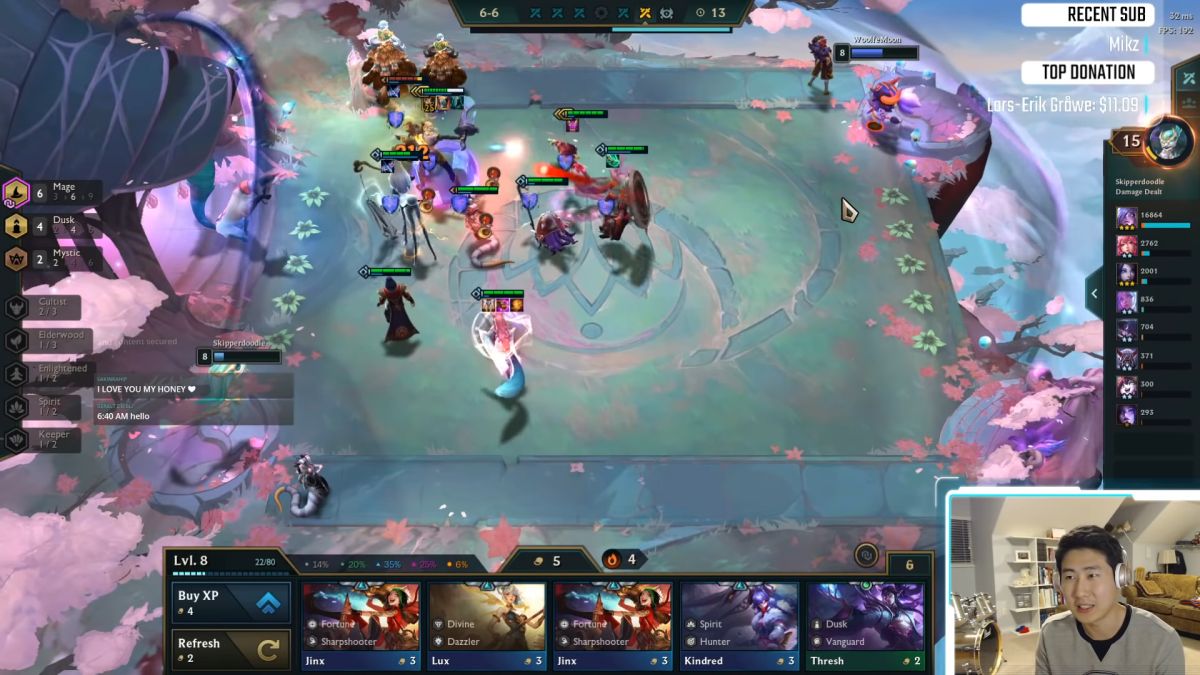
The great contrast to this in Set Four was, once again, the Dusk trait and the presence of Jhin as a champion. I loved the Dusk trait specifically because there was so much room for flexibility in its itemization. Tank items could be placed on Thresh, Casseiopeia, or Riven as the situation demanded. Casseiopeia made good use of AP items but could also equip the aforementioned tank items or serve as a good holder of aura items. Riven was particularly great for flexible play because she could be built in innumerable different ways. Players could give Riven a Blue Buff and then load her up with additional AP items to make use of the extra spell power from Dusk 4 or Dusk 6. But she could also wear purely defensive items and serve as a decent carry with them, providing a path to victory for the poor player who keeps getting nothing but Belts and Cloaks and Vests from the item carousels. Or Riven could go the glass cannon route with offensive items and try to rely on lifestealing to stay alive, which was riskier but could result in the highest damage output if she didn't get crowd controlled. Lots of options there for players to explore that could be viable choices.
Finally, there was Jhin who wasn't even a Dusk unit but ended up getting played frequently in Dusk teams alongside Vayne. Jhin's ability converted attack speed into additional attack damage to make him a highly unique form of AD carry. He could make great use of raw AD items like Deathblade and Bloodthirster, or stack attack speed to turn it into attack damage, or find tremendous value in crit items like Infinity Edge and Last Whisper (since Jhin would get the guaranteed crit on his fourth attack), or Jhin could even stack additional AP and convert it into more damage from his passive. Deathcap was a surprisingly good item on Jhin due to this property, which was the same reason why he was a popular unit for Dusk 6 comps with a Dusk spatula added. Anyway, the point is that the Dusk trait and the presence of units like Riven and Jhin ensured that players had many different viable itemization paths for their carries. Players could roll a Chosen Riven or Chosen Ashe in the store and quickly pivot into a new team instead of being locked into a Kayle comp based on the items that had appeared across the early course of the game. This isn't to say that everything was perfect in Set Four (Warwick always caused balanced problems similar to Olaf in Set 4.5) but the overall situation was definitely better. The gameplay was more flexible and there were more opportunities for switching things up depending on what units and items the player was randoming into. And when there are more opportunities for the players, the outcome of each game is decided more by skill expression and less by who happened to get the most favorable RNG.
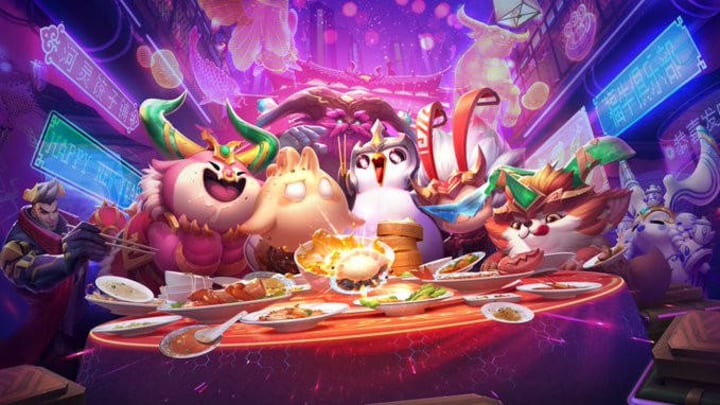
If there's one additional change in Set 4.5 that symbolized the issues with the whole set, it would be the creation of the Lucky Lantern mechanic. Lanterns had 25% odds of appearing after the Stage 2, Stage 3, or Stage 4 carousels, or alternately not appearing at all in that game. These Lanterns could contain a normal item component or potentially one of four special items new to Set 4.5. These included the Reforger which could change items into other random items, the Magnetic Remover which would take items off a champion, and the Training Dummy which added another target to the battlefield map. My least favorite of these additions was the Loaded Dice, which could be used on a champion to re-roll a shop containing only the traits on the champion selected. Everyone received the same stuff from the Latern when it appeared and the idea was that players would have to adapt to what they were given and make creative use of whatever popped out.
The problem with the Lantern is that it introduced another big honking piece of RNG into the gameplay in a way that enormously favored certain team comps over other team comps. The Loaded Dice in particular were vastly better for certain teams than others, especially re-roll comps that would hit their 3 star units much faster and spike much sooner than normal. Every Lantern also had 2% odds to give everyone a spatula and 2.5% odds to give everyone a Neeko's Help which, again, vastly benefitted some team setups more than others. Duelist teams and Warlord teams absolutely loved that free spatula, Keeper teams not so much. I disliked the Lantern because there was no way to plan for it ahead of time, no way to know what item components or Latern items would appear, and certain players would gain major advantages based on what showed up in there. Yes, Teamfight Tactics is a game full of controlled randomness and adapting to the current situation, but there's not much room for pivoting in response to a Stage 4 Lantern when most of the lobby is already below 50 HP. There was plenty of randomness already present in TFT between the items, the champions that appeared in the store, and the fight RNG without needing to add this additional bit. The Lanterns felt way too much like the Set Three galaxies to me, gimmicky stuff thrown into the gameplay that made the overall product weaker, not stronger.
Now with all of that said, I still think that Set 4.5 was pretty good overall. The gameplay balance was honestly better than I was expecting, and if it fell short of the last few patches of Set Four, well, it was a high bar to clear. The designers had to implement some new things into Set 4.5 to help keep the gameplay fresh, and although I think they weren't entirely able to achieve their goals, they did a reasonably good job. TFT has a ludicrously short span of time between sets and I'm sure that half of the design team was off working on Set Five since it was due to be released a mere 90 days after Set 4.5 began. I still wish that they would slow things down a bit and stop catering to the people who play ten games a day and burn out on the patches in 48 hours. But that's where the money comes from since those are the people buying all those silly Little Legends and arena skins which means that this isn't going to change.
Set 4.5 was a step backwards from Set Four while still being a solid addition to the series. And I think the designers will be reasonably happy with that outcome. Thanks again for reading these thoughts!



